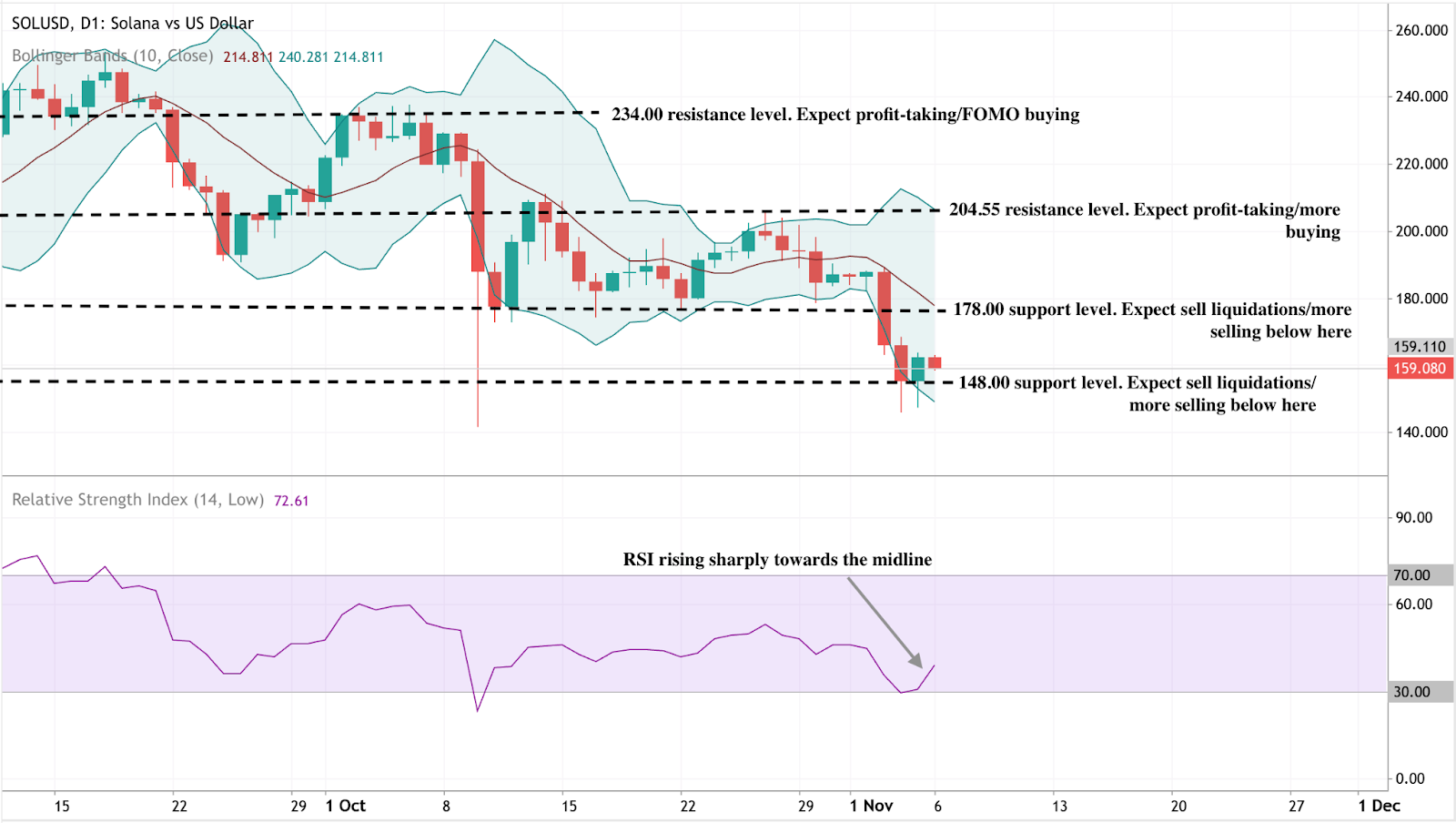Solana’s ETF momentum: How integration is reshaping crypto in 2025
Solana’s ETF momentum: How integration is reshaping crypto in 2025
Solana’s ETF momentum: How integration is reshaping crypto in 2025

Solana’s growing web of real-world integrations - spanning institutional ETFs, payment networks, and decentralised finance (DeFi) ecosystems - is redefining what it means for a blockchain to scale effectively in 2025. The network’s maturing validator system, steady ETF inflows, and expanding partnerships demonstrate that Solana’s evolution now extends beyond speculative cycles to long-term financial and operational utility.
Key takeaways
- Institutional inflows stay consistent: Solana ETFs have now seen six straight days of positive inflows, signalling sustained interest from long-term investors.
- Retail participation revives: Futures open interest has climbed to $7.64 billion, up 2.73% in a day, as traders regain confidence and funding rates move into positive territory.
- Real-world adoption accelerates: Solana is among the networks being assessed for Western Union’s blockchain remittance pilot – a potential milestone for mainstream payments.
- Network performance improves: Validator numbers have dropped by 64% since early 2023, yet network efficiency has increased as outdated nodes were retired.
- Liquidity risks linger: Even with Solana’s total value locked (TVL) rising to $10.2 billion, stablecoin liquidity has fallen by over 8% this week, hinting at short-term pressure on on-chain demand.
Solana institutional investment anchors momentum
Institutional appetite has become the cornerstone of Solana’s resilience this year. The Bitwise Solana Staking ETF (BSOL) recorded $417 million in inflows during its first week - surpassing both Bitcoin and Ethereum equivalents - while the Grayscale Solana Trust (GSOL) attracted over $1 million on launch day.
These sustained inflows highlight Solana’s shift from a speculative asset to a structured investment product. Across six consecutive days, Solana ETFs have generated net inflows of $9.7 million mid-week, reflecting professional investors’ willingness to hold through broader market uncertainty.

The rise of regulated ETFs introduces fresh transparency and liquidity to the market. Each inflow reinforces institutional confidence in Solana’s long-term sustainability – a particularly encouraging sign for a sector still rebuilding trust after the volatility of 2022–23.
Solana retail traders re-engage as on-chain data strengthens
Retail interest in Solana is showing signs of renewed strength. Data from CoinGlass revealed that futures open interest grew 2.73% within 24 hours, while funding rates flipped positive – a sign that traders are leaning bullish once again.
Short liquidations worth $7.19 million exceeded long liquidations of $4.73 million, indicating a squeeze on bearish positions and upward momentum in the price. With a long-to-short ratio of 0.9912, sentiment remains cautiously optimistic but balanced.

For retail traders seeking exposure, Solana CFDs are available on Deriv MT5, where advanced charting tools and multiple order types allow precise execution.
Solana validator reforms make the network leaner and faster
Solana’s validator base has contracted sharply from around 2,500 to fewer than 900 since 2023 - a deliberate move that has strengthened performance. The majority of removals targeted underperforming or exploitative validators that slowed transactions or facilitated predatory trading tactics.
Under its new subsidy programme, the Solana Foundation now removes three subsidised validators for every new one added. This selective approach has resulted in smoother transaction throughput and a more robust overall network architecture.
According to Tomas Eminger, Chief Infrastructure Officer at RockawayX, this streamlining has improved hardware standards and eliminated inefficiencies that previously hindered the blockchain’s performance.
Solana real-world adoption: From DeFi to payments
Beyond market speculation, Solana is strengthening its institutional relevance through real-world adoption. Western Union has officially partnered with Solana to develop and test blockchain-powered cross-border transfer systems.
Meanwhile, DeFi innovation continues at pace:
- New perpetual futures markets are active.
- Launchpads are supporting faster token issuance.
- Simplified asset-listing frameworks are making it easier for fintech firms to join the network.
Together, these developments position Solana for practical adoption - not just yield-seeking activity. This evolution mirrors how early cloud technologies matured from experimental tools into the backbone of enterprise systems.
Solana’s liquidity constraints: The risk beneath the rally
Despite steady progress, Solana’s liquidity picture is uneven. DeFiLlama data show that while Solana’s TVL rose 2.27% in 24 hours to $10.215 billion, its stablecoin market capitalisation fell 8.16% to $13.816 billion.

Shrinking stablecoin reserves often indicate reduced liquidity for DeFi projects, which can limit transaction volumes even during market uptrends. To offset this, Solana may need ongoing institutional inflows or new payment-related activity to sustain growth.
Before executing a trade, you can use the Deriv trading calculator to measure potential profit, loss, and required margin - helping you manage volatility more effectively.
Comparing Solana’s institutional path to gold’s macro role
Solana’s performance in 2025 shares parallels with gold’s steady resilience during macroeconomic uncertainty. Both assets are viewed as alternative stores of value - liquid, yet stable enough to attract cautious capital.
Much like gold ETFs legitimised physical bullion as a mainstream portfolio component two decades ago, Solana’s regulated ETFs are opening a compliant gateway for institutional investors seeking digital exposure.
If the Federal Reserve signals extended policy tightness later this year, risk assets could face headwinds. Yet, steady inflows into Solana suggest growing recognition of the network as a credible digital infrastructure asset capable of withstanding such pressure.
Solana trading strategies on Deriv
Breakout trading: Utilise Bollinger Bands or trendlines on Deriv MT5 to capitalise on strong, volatility-driven moves. A confirmed breakout above $178 could indicate the next upward phase.
Swing trading: Combine RSI readings with moving averages to identify medium-term opportunities. Use the Deriv Trading Calculator to plan entry points and adjust lot sizes to fit your risk tolerance.
Range trading: In consolidating markets, buying near support and selling near resistance can be an effective strategy. Deriv’s tight spreads and flexible leverage make these short-term strategies efficient for active traders.
Solana price prediction and investment Outlook
Solana’s ongoing transformation represents a gradual shift from speculative enthusiasm to institutional maturity.
- Short-term: Prices may fluctuate in response to ETF inflows and macroeconomic sentiment.
- Medium term: Broader payment and DeFi adoption could deepen liquidity and attract longer-term investors.
- Long term: With stronger institutional participation and efficient scaling, Solana is emerging as a credible asset bridging blockchain innovation and real-world finance.
In 2025, Solana’s most important story isn’t its day-to-day price action - it’s the solid institutional and infrastructural foundations forming underneath it.
Solana technical insights
Solana is currently consolidating around $159 after rebounding from the $148 support zone – a level that, if broken, could trigger further downside. The RSI at 72.6 points to strengthening momentum and possible short-term recovery.
The Bollinger Bands show prices nearing the lower band, often a precursor to mean reversion if buying demand continues. Resistance remains near $178, followed by $204.55, where traders may begin to realise profits.

The performance figures quoted are not a guarantee of future performance.















